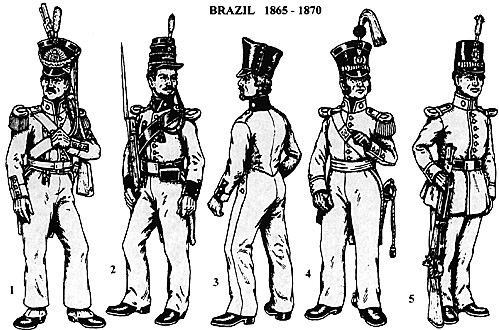FIG.2: National Guard Cacador, Model 1851, Full Dress: Black conical shako with brass bugle and Imperial crown on the front, national cockade and dark green plume, wrapped with black cords. Dark green coatee with black collar and cuffs, white skirt linings, brass buttons, dark green contre-epaulets with brass crescents, white discs on the collar. White trousers and gloves, black belts. Curiously, this is the only dark green uniform depicted in "Barroso" among the various Model 1851 uniforms. A Cacador officer depicted wears an almost identical uniform (barring the distinction of rank), except that his coatee appears to be dark blue, rather than green. An officer and Cacador depicted in "second uniform" are also dressed in dark blue. Assuming this is not simply a printing error, I could not even hazard a guess as to the reason for this variation. It is unclear if these Cacador companies survived the re-organisation of the National Guard in 1865-66, personally, I suspect they were probably "standardised" out of existence at this point.
FIG.3: Cacador, Model 1851, Second Uniform (undress): Wide topped shako in black oil-cloth cover fastened by a row of brass buttons down the side. Dark blue waist-length jacket with black collar and cuff flaps, brass buttons, white collar disc and trousers. These "Second Uniforms" would probably have constituted the field uniforms of the period and show considerable variation from one branch to another. The totally different shako model worn with undress remains totally unexplained. An officer depicted in "Second Uniform" wears a similar uniform, but with a tunic in place of the jacket, having a gold rank stripe circling the cuff.
FIG.4: National Guard Artillery Officer, Model 1851, Full Dress: Black shako with gilt plate and chin-scales, national cockade, red "waterfall" plume issuing from a black ball pompom. Dark blue coatee with what appears to be dark green collar and cuffs (though they might be intended as black, or discoloured), both edged with red piping, red tail lining and turnbacks, gold buttons, epaulets and collar discs. Red or crimson waist- sash (with tassels on the right hip), white trousers, black gloves, sabre with gold knot on a white bandolier with gilt breast plate.
FIG.5: National Guard Reserve Infantryman, Model 1851, Full Dress: Black cylindrical shako which appears to be covered with oilcloth, brass elongated star plate and chin-scales, national cockade and white plume. Dark blue tunic with dark blue collar and cuffs, all edged with white piping, white collar discs, brass buttons, dark blue contra- epaulets with white strap edging and brass crescents. White trousers and gloves, black waist-belt and musket strap.

Uniform Plates
Back to Table of Contents -- El Dorado Vol VIII No. 3
Back to El Dorado List of Issues
Back to MagWeb Master Magazine List
© Copyright 1998 by The South and Central Military Historians Society
This article appears in MagWeb (Magazine Web) on the Internet World Wide Web.
Other military history articles and gaming articles are available at http://www.magweb.com